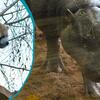Alex Ball, Wildgenes programme manager from The Royal Zoological Society of Scotland (RZSS) updates us on the conservation work with the Himalayan Wolves Project:
"Our RZSS WildGenes experts have been working with Dr Geraldine Werhahn for more than six years on the Himalayan Wolves Project, which aims to gather scientific evidence to support the conservation of wolves, and their prey, in the high-altitude habitats across the Himalayas.
An often-overlooked species, the Himalayan wolf is frequently persecuted by local people, where hunting takes place to prevent livestock depredation, or in retaliation to predation events, or for the trade in traditional and medical products.
Working together we have learned a lot about this elusive carnivore (see previous blog posts and scientific papers). Now as the next exciting project phase continues with science and collaboration at its heart, we wanted to share some developments from recent months...
In the Field
The field team carried out a successful field expedition to upper Humla Nepal and is continuing to monitor the wolves in the area. For us here at RZSS WildGenes, this means looking at wolf scat!
Due to their harsh high-altitude Himalayan habitats, the team is currently exploring whether non-invasive genetic sampling or camera traps are a more effective method of monitoring populations in the long term.
Alongside this, it is important to ensure there is enough prey by monitoring the number of ungulates, like blue sheep, Kiang and Tibetan gazelle, and small mammal populations such as marmots also found in the areas where the wolves live. During the recent field expedition, the team were happy to report healthy populations of these ungulates as well as many Himalayan marmots and woolly hare.
In the Community
No conflict with wolves has been reported by local people this year, which is a promising sign of progress. Locals are also keeping fewer livestock these days due to better alternative sources of income and the increased vigilance required to herd livestock present in wolf habitat.
This trend of fewer livestock combined with healthy prey populations could create a positive coexistence of humans and wolves.
Another vivid illustration of this was an observation of a wolf pack with seven pups thriving in the pasturelands less than a kilometer away from a livestock herd with 75 female yak-cow hybrids and their young without any conflict.
Looking to the future
These are wonderful developments and illustrate the importance of healthy wild prey populations to encourage a positive human-wolf coexistence. To get a more detailed understanding of what the wolves eat, the team are now also conducting a diet analysis through genetic sampling with the method developed and tested by our charity’s RZSS WildGenes lab.
As we move into this new phase, we will be conducting a diverse range of activities with local communities, including improving infrastructure to keep livestock safe, forming community conservation groups, running educational workshops and distributing our educative animal book titled “The Web of Life - A Transhimalayan Animal Adventure.”
Make sure you are following RZSS across social media for more updates."
Alex Ball
- RZSS Wildgenes programme manager
All blogs reflect the views of their author and are not a reflection of BIAZA's positions.
Related Members
-
News
 Blog: Closing the cyber security gap 5th January, 2026Start your year with some due diligence around cyber security - if you're a small or medium-sized business, Lycetts (Insurance Brokers and Financial…
Blog: Closing the cyber security gap 5th January, 2026Start your year with some due diligence around cyber security - if you're a small or medium-sized business, Lycetts (Insurance Brokers and Financial… -
News
 Belfast Zoo helps to bring Christmas joy to Children’s Hospital 19th December, 2025Belfast Zoo joined the Lord Mayor of Belfast, Councillor Tracy Kelly, on Monday (15th December) to help bring festive cheer to the Royal Belfast Hospital…
Belfast Zoo helps to bring Christmas joy to Children’s Hospital 19th December, 2025Belfast Zoo joined the Lord Mayor of Belfast, Councillor Tracy Kelly, on Monday (15th December) to help bring festive cheer to the Royal Belfast Hospital… -
News
 Colchester Zoological Society welcomes new arrivals 19th December, 2025This December, Colchester Zoological Society (CZS) welcomed some exciting new arrivals! A young male pygmy hippo, Mikolas, from Zoo Dvur Kralove…
Colchester Zoological Society welcomes new arrivals 19th December, 2025This December, Colchester Zoological Society (CZS) welcomed some exciting new arrivals! A young male pygmy hippo, Mikolas, from Zoo Dvur Kralove…


